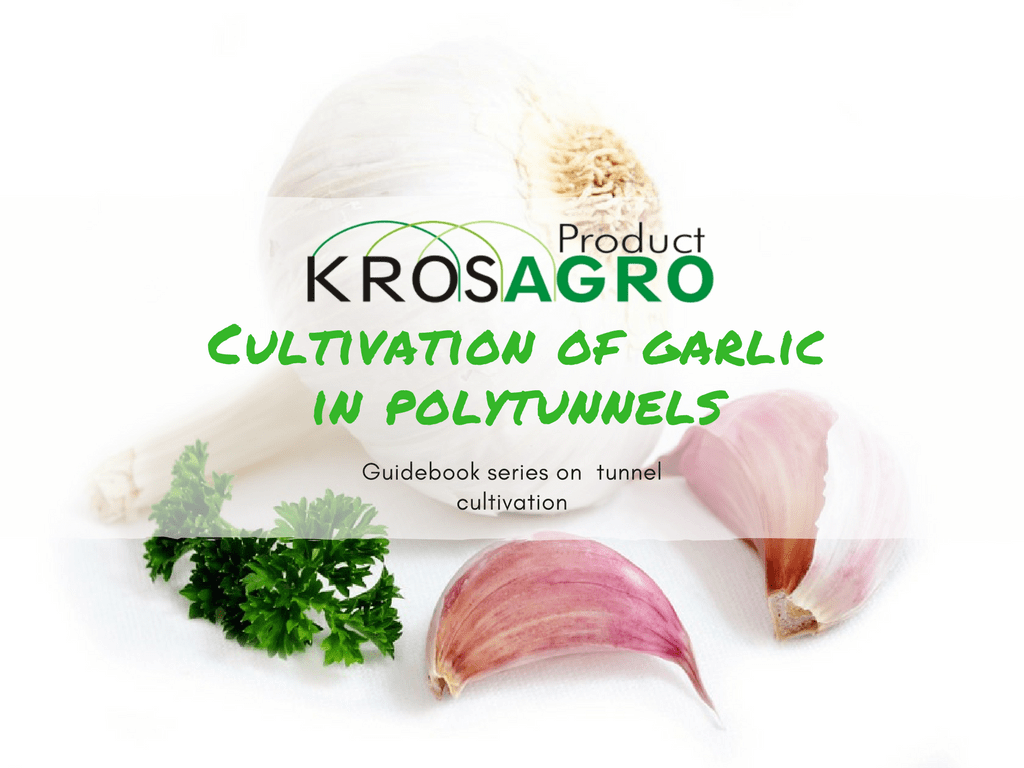It is one of the most popular condiment used in kitchens all over the world. Although some people avoid garlic because of its intense taste and aroma, this plant possesses quite a number of medicinal properties. By cultivating garlic under cover, gardeners have a quick and easy access to a natural prebiotic that effectively counteracts many diseases, strengthens immunity, inhibits the growth of bacteria and infection. Just eat one clove of garlic a day to feel its positive effect after a short time. This constitutes a sufficient dose of amino acids, saponins, vitamins, provitamins, mineral salts and rare elements contained in a small portion of garlic, replacing many drugs from the pharmacy. In addition, cultivation of garlic in foil tunnels allows for planting and harvesting throughout the year.
In this article of the series, we will see how winter garlic differs from spring garlic and review how to grow , plant, care for garlic and when to harvest it to make a tasty and beneficial cooking ingredient.
Contents
Winter or spring garlic ?
Garlic is planted in two cycles, spring and autumn. Garlic winter, planted in autumn, does not develop flower shoots. It hibernates in winter and emerges in spring. Spring garlic, on the other hand, is planted in spring.
Winter varieties develop larger heads and ripen much earlier than spring varieties. They reach up to 120 cm in height, with bulbs up to 90 g in weight.
Soil and climatic requirements
- Soil
Garlic is a plant resistant to low temperatures, growth occurring at just 3 ° C. For proper development, it needs sun exposure, although it can be planted in the shade. As a one-year plant, it has a weak root system. This translates into high demands on soil and water. Garlic needs moist, warm and rich soil in humus and nutrients. The optimum condition for its development is a neutral ground with a pH of about 6.8.
- Planting
Garlic cloves are placed in the garden greenhouse in October and the end of March or beginning of April. Put the little bulb 5cm deep into the ground. So that the pointed tip faces up, and then cover with a few centimeters of soil.
- Mulching
Mulching is a treatment that has a positive effect on the yield . As the edible part of the plant is under ground, the main factor affecting garlic is the substrate quality. A mulch layer protects the soil from drying and limits development of weeds. Proper irrigation is equally important during cultivation, soaked soil causes the plant to be exposed to disease and pest attacks.
Intercropping – garlic
Garlic is a universal plant for intercropping. It is planted to prevent parasitic diseases caused by fungi. Its intense scent deters a significant proportion of pests. A good combination will be the planting of garlic in the vicinity of carrots, cucumbers, tomatoes and lettuce. It is not recommended to combine it in an area with legumes (beans, peas) and brassica, such as cauliflower and broccoli. Nothing stops you to cultivate it inside the tunnel, next to bushes and fruit trees.
- Rotation
You should avoid growing it year after year in the same spot or after other relatives . Such action can lead to development of diseases and pests that appear on the same plant family. Planting it also close to vegetables that consume a lot of nutrients leads to low yields.
- Fore crop
Good fore crops for garlic would be peas, beans, and any fabaceae plants.
Garlic care
As we have already mentioned, garlic has high demand on soil and water, so it is necessary to systematically water and loosen the soil. As with any plant, it is important to systematically remove weeds and keep a constant watch on the crop. When pathogens or pests appear, they must first be identified, to then apply the appropriate remedy depending on the growing stage.
To increase yield, flower buds should be removed – this will allow garlic to develop bulb instead of stems.
- Fertilization
You can use organic fertilizers, compost, green manure, manure and bio humus to fertilize garlic. When using mineral fertilizers, it is important to remember that garlic only partially tolerates chlorides. So when choosing mineral fertilizer, you should buy one with a low content.
Harvest
When stems on garlic become brown, then it is time to harvest. When more than half of them have reached this state, it is a sign that they are already fully mature. Garlic ready to harvest should have a hard head or 3 to 5 segments covered with thin skin. Garlic is dug during dry and sunny days, gently removing it, so as not to damage the head itself. Shaking it off the ground and hanging it to dry for at least 3 days is an effective solution to prolong its shelf life.
Storage
To store garlic for months, place it in a dark, cool and ventilated room where humidity is maintained at 70% , preferably with a temperature not exceeding 5°C. Keeping garlic this way will prolong its goodness and allows for use as a seed.

